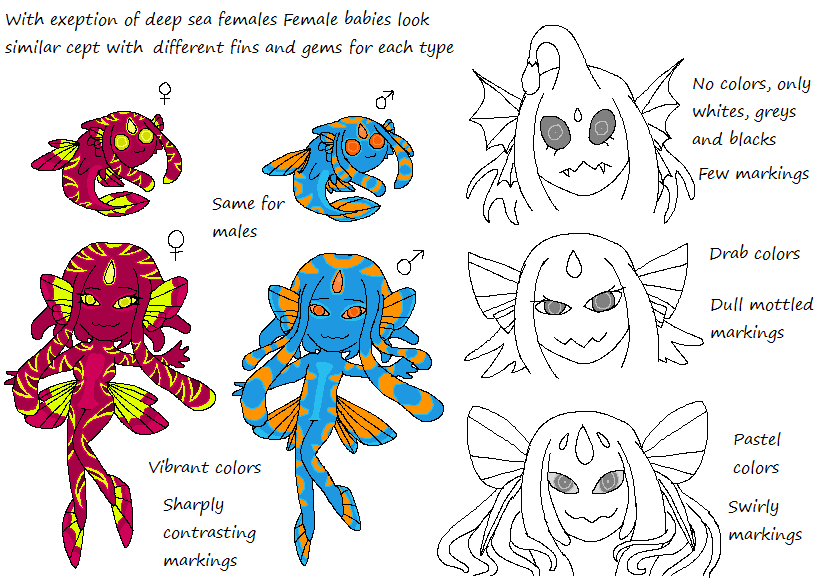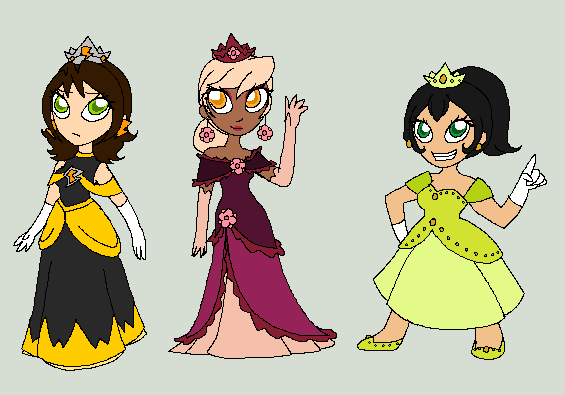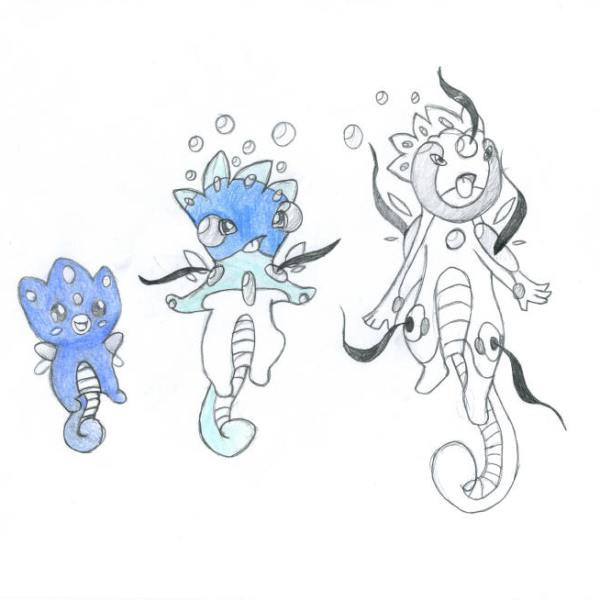HOME | DD
 starflash111 — Aquali reference sheet and more info
starflash111 — Aquali reference sheet and more info

Published: 2013-04-11 13:36:19 +0000 UTC; Views: 1315; Favourites: 33; Downloads: 3
Redirect to original
Description
MAJORITY OF THE INFO HERE: [link]Those colors and patterns are examples, they can be many different colors.
I put obvious gender differences and such.
I drew uncolored examples of the other kinds and labeled them with the color types and pattern types..too exhausted to color them.
RANDOM PHYSICAL FACTS
The gem is always the same color as the ring in their eye.
Aquali names can be any name...if you take out the vowels.
The Butterfly fin one looks derpy....
Butterfly Fin Aqualli also have a high male to female ratio, with females being even rarer, hence the reason for not so many of them.
As for the deep sea Aquali, the females are much larger than the males and are more dominant.
Colder climate Aquali are duller so they can camouflage as where they live has massive predators so being able to hide is optimum.
Deep sea Aquali babies are bigger and fiercer than regular babies if female, and smaller and almost feminine looking if male.
Tropical Aquali (The colored examples) live in groups of up to 15 with a Butterfly Fin leading them if possible. Colder climate Aquali are loners, living alone until they need to breed. And deep sea Aquali live in heterosexual pairs, though there are rare cases of same sex pairs.
Deep Sea Aquali are the weakest psychically but the strongest physically. on the other end of the scale are the Butterfly fins, who are weak physically but the strongest psychically. Tropical and cold climate Aquali fall in the middle area.
DIET
Tropical Aquali eat several strains of seagrass (the ones prefer have longer and thicker leaves that are nutritious and a couple of the strains have edible nodes around their bases) and the non poisonous varieties of fish, crustacean, gastropod and cephalopod species that live in the grasses and the surrounding area. they also eat rock clinging molluscs that they find in the coves or lagoons where they commonly sleep.
Butterfly fins(The genetically mutated version of the tropical Aquali) are unusual compared to tropicals as they tend to head off alone to feed and favor several poisonous species that live in the reefs, and a strain of poisonous seaweed known as ‘Siren’s hair’ as their foods of choice as they appear to be resistant to the poisonous barbs and flesh. This might have to do with the toxin resistant swarms of jellyfish that generally accompany the Siren’s hair, which are also eaten by the Butterfly Fins.
Colder climate Aquali hunt larger yet less common species of fish and crustaceans, with the occasional sea faring mammal thrown in should the opportunity present itself. They occasionally eat aquatic vegetation, usually drifting species or types of sargassum seaweed. Their intake of vegetation is increased when breeding season comes around as where they breed has much more edible vegetation. They also kill and eat weaker Aquali if presented with the opportunity.
Deep sea Aquali very, VERY rarely eat vegetation. They eat meat the majority of the time and have been known to eat each other if food in the area is scarce for an extended period of time. Favored prey include a kind of shark that ressembles a cross between a Goblin Shark and a Frilled Shark, deep sea cephalopods, a kind of giant deep sea lobster which is hard to kill but is very nutritious and a type of large tube worm-like creature that has multiple appendages and seems to regrow torn off ones, making it a very valuable food source.
BEHAVIOR (EXTRA)
Tropicals are vey social and often form pods comprised mostly of siblings from the clutch of eggs they hatched from. This generally causes a Westermarck Effect which means that a tropical will seldom breed with another pod member as they cannot see them in that way. They’re highly protective of pod members and will utilize their psychic abilities collectively to drive away any threats should a pod member be in danger. They have a symbiotic relationship with Butterfly fins, who lead them and help protect the pod in exchange for company and protection themselves. They only migrate to colder waters to breed, swimming deeper to the sunken ruins of cities and town to mate and lay their clutches of eggs or when vegetation becomes scarce.
Butterfly fins have a symbiotic relationship with Tropical and often lead pods of them. They become pod leaders when they are young, psychically attracting potential pod members (they tend to focus on sibling groups) to them and gradually building up their pods member by member. They are formidable when provoked, often attempting to crush threats psychically with their immense abilities or rallying the combined abilities of their pod to deliver a devastating psychic attack. When they need to breed they separate from their pod and head to a separate area , searching for a female of their kind to breed with which can take longer than the other types as females are elusive, even more so than the males.
Cold Climate Aquali are loners, only meeting up in non hostile situations to breed. While not as hostile as Deep Sea Aquali, they prefer to live and hunt alone as a single Aquali hiding is less likely to be found then many. They, unlike other Aquali will use their abilities to lure prey to them and make them less likely to fight back. They will often try to bury themselves in the sand or rocks if a predator approaches and will try to force the predator away psychically.
Deep Sea Aquali are roamers. They never settle down and are nearly constantly on the move. They generally pair up with their chosen mate shortly before maturing and the two will travel and live together, the male guarding the females blind spots and alerting her to danger, the female hunting for the both of them and protecting the male. Their eggs are laid in holes dug by the parents and are covered, being guarded by the parents until they hatch. This is done in areas with enough food and shelter and thee are usually several pairs per area, the imminent parenthood seemingly overriding the aggressive natures of the females and enabling them to share the area.
HABITAT
Tropical Aquali tend to live close to the islands as the planet’s equator, as it’s warmer and the islands provide the coves and lagoon they need for shelter. This applies to Butterfly Fins as well. They require reefs, seagrass and abundant food for an environment to be suitable and when migrating will often specifically look for these things, refusing to settle down if there are any of those things absent in an area.
As for colder climate Aquali they prefer to live closer to the northern and southern poles of the planet and shelter in the sand or in aquatic caves. As with the tropicals prey is essential, and the fewer predators the better. Areas to hide are also essential and a cold climate Aquali will often stay in a chosen area for years if it’s suitable.
Deep Sea Aquali roam the chasms of the deepest areas of the oceans and do not usually seek shelter, often stopping and resting when ever they feel tired. they’re very seen above the abyssopelagic depth of the ocean. Open, unobstructed waters are their ideal hunting ground, and areas with or near caves and chasms are best fo when they wish to breed or die.
PLANETARY ENVIRONMENT
The planet on which they reside is almost completely covered in water, with only a few islands scattered here and there. It wasn’t always like this though, it was once the frozen home world of a cold loving sentient race before the waters rose, claiming their land, cities and towns as the planet began to warm and thaw. The race eventually abandoned their home world in favor of the stars, leaving the continents to flood and the most intelligent aquatic life to become dominant and begin gradually evolving, eventually becoming the Aquali and a few select other species after hundreds of thousands of years. There are only a few genuinely frozen areas left on the planet, mostly located at the northern and southern poles and the areas surrounding them.
PREDATORS
Aquali only really have one predator that is a danger to all of them, and they are the various strains of a creature known as a Codilo. Codilo are large reptilian creatures that have many different types, much like the Aquali. They have tough diamond shaped scales, large and thick limbs and long flat tails that serve as their main method of propulsion. They hunt in packs, making them very formidable and will often kill entire tropical pods if they can get past the psychic barrage. (I will wite up and draw these creatures next.)
As said in the other pic these are an open species. Just credit me should you ever decide to make one :U
And great googly moogly those patterns were hard to draw...my wrist hurts..
Related content
Comments: 16

The last one is a butterfly Fin Aquali C:
👍: 0 ⏩: 1

Can I make one even if its rare?
👍: 0 ⏩: 1

Yes, seeing as your the first person who's wanted to ;7;
👍: 0 ⏩: 1

Pretty interesting C: Codilos sound REALLY nasty.
👍: 0 ⏩: 1

They are c:
They've also got very large mouths with rows of teeth :U
👍: 0 ⏩: 1

Ooh, that sounds scary if you ran into one of those.
👍: 0 ⏩: 0

It looks very good mate, and according to what I read, if I understood rigth, the faces at the right dare for diferent environements right?
👍: 0 ⏩: 1

Yes, yes they are c:
I'm adding the information I wasn't able to add last night that goes into further detail about them.
👍: 0 ⏩: 1

Oh ok, lets read it then...
👍: 0 ⏩: 1

I lost it.
I need to retype the six hours worth of typing I lost through my browser being an ass.
👍: 0 ⏩: 1
























